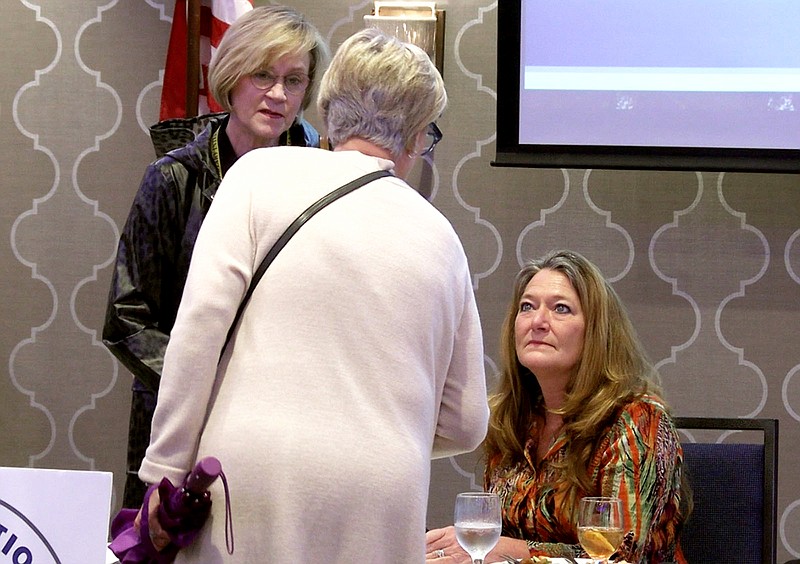A $150 billion industry, human trafficking is second only to drug trafficking, Shawnee Cooper, Arkansas ambassador for Rotarian Action Group Against Slavery, told members of the Hot Springs National Park Rotary Club on Wednesday.
"Drugs, you sell once," she said. "A human, you can sell over and over again."
After retiring, Cooper was sitting on the couch one day watching "Dr. Phil," she said. The show that day in the early 2000s featured a 13-year-old girl, who had been communicating online with who she thought was a young boy for about eight months, Cooper said. It was actually a man in his 30s.
"Finally, he convinced her to maybe meet him just on the corner by her house," she said. "They were eating dinner, so she asked her mom if she could be excused and that she didn't feel very well. She was going to her room, (or) so her mom thought. She actually went out the front door. Her mom and dad didn't even know she was gone.
"They were only able to find her because he livestreamed her rape and beating, and so the FBI were able to locate her. And so, now she goes to schools and she talks to kids not because it was her fault, but because how easy she was manipulated."
There are more than 40 million human slaves in the world, more than there have ever been, Cooper said.
Human slaves not only include people forced into labor or sex, but also child soldiering, child brides and organ trafficking. However, the most prominent forms of human trafficking in the U.S. involve labor and sex, she said.
With 12 grandchildren herself, Cooper said she worried about them being on their phones so often.
"One in five children will be approached by a trafficker online before the age of 18," she said. So, whenever you think about that, 20% of our kids are gonna be victims, and how are they gonna respond to that?"
The average age of people sold into prostitution is 12-14, she said. A misconception about trafficking and kidnapping is the assumption of people being taken off the street, which does happen, but the majority of victims know their abuser.
Traffickers seek out vulnerable people and children, including those who are homeless. Out of more than 1.5 million children who run away from home, a third of them will be approached by a trafficker within just a few days of being homeless, Cooper said.
"It takes them no time to find the most vulnerable people," she said. "And that's what they're looking for. They're wanting somebody vulnerable. Well, whenever you look at the state of Arkansas, we have a lot of red flags that make us vulnerable.
"We have poverty, we have a (literacy) problem, there are so many problems we have that red flags our state that we gotta work on to better prepare our kids."
The struggle doesn't end for victims after they get out of the abusive situation. Not only does PTSD affect victims, but the average life span for survivors after they escape is about seven years, Cooper said.
"And whenever you think about that, why is that?" she said. "If they live through the beatings or whatever happens to them when they're on the street, a lot of times, they get addicted to drugs. A lot of times, they are alienated from their family, so they have no family or friends, nobody to fall back on. They can't hold down a job. A lot of times, they get arrested. It's not traffickers that get arrested. It's the prostitutes that get arrested, so then they have a record."
While the traffickers are a major part of the problem, buyers contribute to the trafficking problem, as well. The average buyer is white, between the ages of 35 and 45 years old, Cooper said. They are normally married, have children and normally attend church or claim to be a Christian, according to information from an investigator, she said.
"A lot of times, we get confused on saying 'It's not in our neighborhood' or 'It's not in our state' or 'It's not in our church,'" she said. "It's everywhere. ... So, whenever you say, 'Who are the buyers?' It's not written on their forehead. It is people who look just like you and me. It happens to kids that look just like you and me or our kids. So, we've got to keep our eyes open and be vigilant and try to get things corrected on this."
"Ways to combat human trafficking include deepening our understanding of trafficking networks, strengthening federal efforts through external partnerships, improving coordination among law enforcement to increase accountability for human trafficking, increasing efforts to investigate and prosecute forced labor and continuously reevaluating the authorities and resources to combat human trafficking," according to information from Cooper's presentation.
Other ways to support the effort against human trafficking include supporting survivor-informed interventions, seeking to protect survivors against incarceration, fines or penalties for unlawful acts committed as a direct result of being subjected to trafficking, improving survivor assistance and increasing access to social services for victims of human trafficking to increase stability, according to the presentation.
